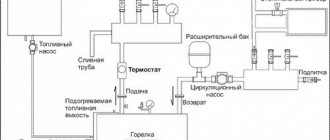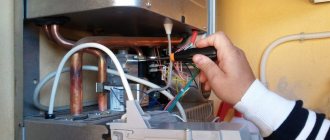What documents are needed to replace a gas boiler in a private house?
The first thing you need to do before installing a new gas appliance in a private residential building is to collect a package of documents.
It includes the following papers:
- a certificate indicating that the new equipment complies with the rules of safe use;
- ventilation/smoke duct inspection report;
- gas equipment service agreement with a warranty period of 1 year;
- project report (if required);
- technical passport for the installed boiler, as well as instructions for its correct use.
Regulatory documents for replacement
Gas heating equipment, if improperly installed, operated or maintained, is a source of danger. Therefore, replacing it is not just the purchase and installation of the required unit, but an entire procedure that is regulated by a number of documents.
All necessary information about replacing gas boilers is freely available. But sometimes it’s not easy to find them, since the topic of gas equipment is regulated by dozens of domestic specialized documents. These include laws, SNiPs based on them, government regulations, etc.
But among them there are a number of documents that are more important to the consumer than all the others. Since the information contained in them will help you understand the nuances of replacing stakes, as well as protect your interests from possible incorrect actions of city gas representatives.
Replacing a gas boiler is a carefully regulated procedure that requires certain knowledge. As a result, there are many requirements and rules that must be strictly followed.
The most requested documents include:
- SNiP 2.04.08-87, which is called “Gas supply”;
- SNiP 42-41-2002 entitled “Gas distribution systems”.
- State Russian Federation dated December 29, 2004 No. 190-FZ (Town Planning Code of the Russian Federation);
- RF PP dated December 30, 2013 No. 1314 (Resolution of the Government of the Russian Federation “On amendments to the rules for connecting ... to gas distribution networks”);
- RF PP dated November 16, 2016 No. 1203 (Resolution of the Government of the Russian Federation “On approval of the rules for connecting ... to gas distribution networks”);
- SNiP II-35-76, which specifies the procedure for connecting boilers;
- Code of Administrative Offenses of the Russian Federation dated December 30, 2001 N 195-FZ (Code of Laws on Administrative Offences).
Please remember that, if necessary, you should use their latest versions, which contain current articles with the latest changes and additions.
Gas boiler installation standards
There are strict rules for replacing a gas boiler in a private house, which must be observed when carrying out work:
- more than 4 m2 of area must be allocated for installation;
- the width of the entrance door must exceed 80 cm;
- you need to choose bright rooms, the window area is calculated based on the standard of 0.3 m2 per 10 m3 of volume;
- ceiling height – from 2.5 m;
- it is necessary to have a pipeline with cold liquid;
- the cross-section of the chimney must correspond to the power of the gas boiler;
- It is desirable that the wall panels are level.
Based on these rules, the most appropriate solution seems to be to install a wall-mounted boiler in the kitchen of the house. This room has all the conditions for it, and, thanks to its small dimensions, it can be hidden in a closet. But it is better to install a floor-standing gas boiler in a separate boiler room.
Penalties for replacement without approval
If the permit was not issued and the installation of new gas equipment was not approved, according to Russian law, the owner of a private house will have to pay a fine. This follows from Article No. 7.19 of the Code of Administrative Offences. The amounts that will have to be paid for violating this rule are also indicated there.
The fine ranges from 10,000 to 15,000 rubles. If an emergency occurs due to an incorrect and unauthorized change from one gas apparatus to another, criminal liability may also arise. At the same time, upgrading a gas boiler with your own hands is not allowed.
Where to begin
The choice of a gas device should be based not only on the capabilities of the homeowner.
It is necessary to determine the purpose of the unit; it is available in two formats - with one or two water circuits.
The single-circuit model serves only to heat the room, without obtaining additional benefits.
The dual-circuit device provides hot water and has a built-in coil. You can additionally install a heat accumulator where hot water will accumulate and immediately use hot water supply in large volumes.
You need to purchase equipment in stores where the products are fully certified, an official guarantee is issued, and a receipt is issued.
Gas boiler room standards
Equipment running on gas requires a separate room - a boiler room.
The room should have an area of 4 square meters. m, but the size of the boiler room depends on the power of the device: the more powerful the boiler, the larger the boiler room should be. The ceiling height must be at least 2.7 m.
Devices with a power of up to 15 kW can be installed regardless of the floor, but more productive ones are installed below the level of the first floor, preferably in the basement.
Standard requirements for a boiler room
Installation of the boiler or piping in the kitchen, living rooms, or bathrooms is not allowed.
A door is required with a gap of 2-3 cm at the top or bottom, which will ensure fresh ventilation of the boiler room.
The installation site must be strong and level. If a heavy unit is used, it is better to pour a foundation under it so that the area exceeds the dimensions of the bottom of the boiler by 10 cm in each direction.
Boiler room ventilation diagram
The walls and floors that will directly touch the unit are sheathed with sheet iron and covered with heat-resistant plaster.
A window of 30*30 cm is required, the larger the room, the more windows.
If the equipment has a closed combustion chamber operating on the convection principle, a dedicated room is not required.
The design of the device allows installation near any external wall; a coaxial chimney is used to remove combustion waste.
Coaxial chimney
The peculiarity of the coaxial pipe is the possibility of direct output through the wall, acting as a smoke exhaust and supply ventilation. The chimney simultaneously removes combustion products and captures street air, directing it to the burner.
The type of draft is considered more efficient than using air from the room.
The horizontal part of the pipe located in the house should not be more than 3 m, the number of turns of the chimney should not exceed 3.
Preparing the boiler room for acceptance by the gas service:
Preparing documents
It is necessary to study the standards and rules for installing a gas boiler.
You should familiarize yourself with SNiP 02/31/2001 on gas supply to a private house, 01/41/2003 on ventilation, heating, 01/21/97 on fire safety, 04/2/01-85 on water supply and sewerage. The latter is needed to properly supply water to the heat generator.
More details about the rules for arranging a boiler room are written in SNiP 2.04.08-87.
An application for connection must be sent to the local gas service, with preliminary calculations of the total gas consumption for heating.
To calculate the parameter, indicative SNiP 31-02 has been issued, where paragraph 9.1.3 displays the average daily fuel consumption rates for different devices.
If the answer is positive, the applicant receives a document describing the technical conditions for gas supply. You will be required to fully implement the requirements described in your permit.
Installation of gas equipment requires prior approval, even if the device will be powered by a cylinder.
After ensuring the conditions, they proceed to drawing up an installation project, which will be based on data from the official permit. The scheme is drawn up only by design specialists with a valid license.
An example of a gas boiler installation diagram
The completed project is sent to the local supply service for approval, copies of the technical data sheet of the device, instructions, certificates, examinations with a conclusion on the safety of the boiler are attached.
If the answer is negative, the motivating part will be described with a list of points that require correction. After eliminating the shortcomings, you can resubmit the documents.
Cost of specialist work
Before replacing the boiler, you need to prepare a package of documents and set aside a certain amount of money to pay specialists for gasification of houses.
For the capital of Russia and the Moscow Region, the costs will be about 8,000 - 22,000 rubles, for St. Petersburg - 6 - 15 thousand rubles, for the regions - 4,500 - 12,000 rubles. The indicated amounts are given taking into account the removal of the old device, installation of a new one and various adjustment work.
A little about service
Unfortunately, among consumers who install autonomous heating systems for the first time, they try to save on service maintenance. Indeed, if you refuse it, you can save 10-15 thousand rubles per year. But even after one season has passed, the focus of the burner may shift, carbon deposits may appear, and deviations in the operation of the automation and pump from the specified mode may appear. The error of the work, at first glance, is not great. But it leads to unjustified risk, a decrease in efficiency, and in connection with this, the cost of operating a gas boiler also increases. It is worth saying that it is still worth saving when purchasing a gas boiler, but this must be done competently and carefully, so that you do not have to regret it later.
How to replace a gas boiler in a private house, we’ll figure it out step by step
Let’s put together all the recommendations and rules for the competent, legal reinstallation of gas equipment in a private residential building with a new one. The 2021 rules suggest the following algorithm.
Stage 1: application for approval of technical specifications
To legalize the replacement of boiler equipment, you need to pay a visit to Gorgaz or Raygaz (depending on your place of residence) to submit the appropriate application for the provision of technical conditions (TU). If refurbishment is needed, a design will also need to be made, and for this you need to take out planning permission.
In addition to personal information, as well as data about the boiler and its future location, you will need to indicate in the application the planned volumes of gas consumed. The approximate number of cubic meters can be found in the device passport. If you encounter any difficulties with the calculation, you can seek help from specialists working in the city gas department. To do this, you must first submit a separate application.
After processing the submitted application and performing the necessary calculations, after some time (the date will be announced upon acceptance of the application), the technical specifications will be ready and the owner, upon presentation of a passport to confirm his identity, will receive it. It is believed that the processing time for an application cannot exceed ten working days (two calendar weeks).
By the way! If you do not know which gas authority you need to apply to, pay a visit to the local government organization in your area - they should forward the application to the correct organization within five days.
Stage 2: obtaining agreed specifications
The document issued after submitting the application is called “Technical Conditions”. This is a set of rules that must be adhered to. The data in the technical specifications is indicated in accordance with the current PP No. 1314 (connection rules) dated December 30, 2013 (as amended on March 19, 2020).
After reviewing the received technical conditions, the owner will see that they include requirements for ventilation and smoke systems, as well as instructions for the placement of the unit and device for recording the amount of gas consumed.
Stage 3: drawing up project documentation
New design documentation is not needed (issued at will) if the gas device will not be moved, but will only be replaced with one of similar power. This is stated in the Russian federal law on heat supply, issued under No. 190 of December 29, 2004. The following cases are an exception: more than one family lives in a house; housing intended for private use has more than three floors.
If for some reason you still decide to draw up and sign the project documentation, you will need to provide Gorgaz with a schematic schedule for the installation of gas appliances, which includes chimneys, boilers and other parts of the gas supply system of a private home and gas disposal. You will also need a visual diagram of the laying of the gas pipeline from the main to the building and a communications diagram.
The rules for replacing a gas boiler in a private house require that the above-mentioned papers also be accompanied by a certificate of conformity (if it was purchased from a third party), a grounding loop inspection report, instructions and a passport for the equipment. Gorgaz will also require you to show a service agreement concluded for a period of at least one year.
Stage 4: approval of design documentation
After drawing up the project, it needs to be formalized. Approval is carried out in the same organization - in Gorgaz. After submitting documents and until approval, it can take from seven days to four months (depending on the volume of work of specialized specialists at the city gas enterprise).
If all requirements are met, the gas documentation is approved and the project is successfully approved. To this end, the applicant (owner or owner of the house) is issued a duly certified document, which is an official permit to begin work on replacing the gas unit.
In case of refusal, it will be necessary to bring documents that do not comply with current rules into proper form and correct any errors that were made in them. The organization will issue the applicant with a corresponding written document about what errors occurred.
Stage 5: removing the gas apparatus
Dismantling should only be carried out with special knowledge and skills. This means that you will need to invite a professional to perform such work. He will first disconnect the old device from the gas, water supply and heating system. In addition, water is drained from the unit and all heating pipes.
Stage 6: installation of a new boiler
The installation of a new boiler is carried out by a licensed specialist who understands the issues of gas supply to residential buildings and has permission to perform such manipulations. There is no clear indication that you cannot replace the device yourself (a specialist must only make a direct connection to the gas), so this question remains open.
On the other hand, if the boiler installation/replacement algorithms are violated, the gas service may stop supplying gas for the private needs of the residents of the house. Based on the above, it is best to use the services of experienced specialists.
Stage 7: Test
As already indicated in the description of the sixth stage, the boiler must be connected by a professional. Naturally, the performance test is also carried out by a professional. A full inspection of the installed boiler is first carried out. The equipment is also started for the first time, after which it becomes clear to the specialist what defects or malfunctions are observed in the operation of the boiler.
Based on the test results, the invited employee fills out a report, which is later submitted to Gorgaz. If malfunctions are identified, the owner must eliminate them, after which the test procedure is repeated until a positive result is achieved.
Stage 8: notification to the city gas authority
Replacing an old gas boiler in a private house with a new one ends with contacting Gorgaz to report the replacement. Within five days after completion of the tests, a written application must be submitted to this authority. Don’t forget to attach an annual service agreement and inspection/activation certificates for ventilation.
Replacement procedure
To replace an old unit with a new one, the owner will need to contact the relevant department of the city gas company to clarify possible registration options and the necessary package of documents in relation to the technical parameters of the replacement.
It must be collected in full to avoid problems with the relevant regulatory authorities in the future. The owner has the right to collect these materials on his own or to entrust this procedure to a representative by proxy.
Preparation of technical specifications and implementation of the project
In the case of installing a new, more powerful boiler, the owner receives from the relevant department of Gorgaz technical conditions for the reconstruction of the in-house gas supply system.
Preparation of specifications is carried out in accordance with the law no later than 2 weeks from the date of submission of the application and payment by the customer for services.
In this document, specialists will establish certain requirements for the placement of the boiler, smoke ventilation systems, gas metering devices and intra-house gas networks.
Since specifications are developed based on specific technical parameters of gas supply processes within a specific household, they are unique for each consumer, the property of the customer, and must be registered accordingly. After which the specifications are transferred to the design organization for project development.
The project is developed by a design organization that has permits for the right to carry out the relevant work.
The owner of the premises, ordering a project from the developers, must enter into an agreement with them, preferably on a turnkey basis, so that they independently carry out approvals from the regulatory authorities and only after that pay for the work performed.
Dismantling of old equipment
After the owner has an approved project in hand, according to the “specifications” section, equipment and materials are purchased for the reconstruction of the heat supply source.
After this, you can begin to dismantle the old equipment. If the owner feels that he cannot cope with this on his own, then these are the rules, unless welding is required on the gas pipeline.
The only recommendation is that this work should be carried out in the warm season so that there is no need to heat the house, since dismantling and installation of equipment can take quite a long time from several weeks to several months, everything will depend on the supply of equipment.
After the boiler is turned off and the coolant has cooled to the outside temperature, dismantling measures are carried out:
- Internal cleaning of pipe heating systems. For this operation, the coolant is drained from the network using a drain valve. And then it is filled again through the make-up valve. Thus, washing is performed 3-4 times.
- Shut off the gas line through the main supply valve in the house.
- The cold water supply is shut off for double-circuit boilers.
- The boiler is disconnected from the power supply.
- Disconnect the device pipe for the smoke ventilation system.
- Auxiliary equipment such as fans, burners, and safety automatics with a preostat are removed from the boiler.
- The boiler is removed from the foundation or wall anchors.
- The dismantled boiler is removed from the furnace room or kitchen.
Equipment dismantling must be done very carefully so as not to disrupt the integrity of existing utilities.
You asked, we answer
Despite the abundance of information in open sources, owners of private houses still have many questions about replacing a gas unit. Let's try to explain them.
Is it possible to change the boiler in a private house yourself?
According to the Decree of the State Construction Committee of the Russian Federation No. 170 dated September 27, 2003, there is no ban on removing and carrying out a similar replacement of an old boiler. It turns out that one of the first stages of replacing a boiler, that is, removing the old one, can be done independently.
As for the direct connection of the boiler to gas, this work is performed by a qualified gas service worker. If the unit is replaced with exactly the same one (same manufacturer, identical brand, same power and article number), no additional approval is required, that is, in this case it is possible to do the replacement yourself.
Summarize. The answer to the question whether it is possible to replace a gas boiler yourself is: “yes, if no changes are expected in the equipment model.”
When replacing a gas boiler, do you need to change the design?
A replacement project is required if it is planned to replace the boiler with something other than a similar one. Thus, a project needs to be created when replacing a gas boiler with another, having a different power, a different product, manufactured by a different manufacturer. The project also changes for relocated boilers, if the owner of the house decides to change its location, for example, move it to another room.
Do I need to register a reinstalled boiler?
It is advisable to go through the entire procedure for registering a gas boiler as provided for in the rules and legislative acts of the Russian Federation. If the owner of a private house finds himself in a controversial situation and the gas unit has already been replaced, do not neglect checking with a specialist and registering it. These procedures will finally legitimize the installed equipment and provide you with peace of mind, because you will know that the gas apparatus is safe for use.
What documents are needed to replace a floor-standing gas boiler with a wall-mounted one?
Replacing one type of boiler (floor-mounted) with a completely different type of design (wall-mounted) is mandatory and must be registered after completing all the steps described above. Therefore, a complete package of documents is required for this. Among them:
- statement from the owner and his passport;
- technical specifications;
- a certificate indicating that the wall-mounted device complies with operating standards;
- service contract for 1 year;
- replacement project;
- ventilation duct inspection report;
- boiler test report;
- technical data sheet for the device, operating instructions.
The following documents will be completed and required throughout the boiler replacement process: some in the initial stages, others when commissioning a new wall-mounted boiler.
When planning to replace a gas boiler, you should immediately contact the gas service first. This must be done to submit your application. You can also clarify any unclear questions with the specialists of this organization and consult on the nuances of performing this difficult procedure, which will require the involvement of specialists.
What can be repaired without gas workers?
There are several main causes of malfunctions. This is the incorrect operation of gas equipment, the presence of an unacceptable microclimate in the boiler room, untimely maintenance of all systems or low-quality components.
When making repairs yourself, be sure to observe safety precautions and strictly follow the instructions. First of all, the user should decide which parts of the gas boiler can and cannot be repaired on their own.
When repairing gas equipment, the main danger is a possible gas leak.
Therefore, it is necessary to carry out all manipulations for installation and dismantling of units and parts of the device with caution.
Particular attention should be paid to replacing components related to the fuel supply system.
Knowledge of typical malfunctions of gas boilers and methods for eliminating them allows you to make simple repairs yourself. It is worth remembering that serious repairs can only be carried out by gas workers, but there are procedures available to independent home craftsmen
Boiler manufacturers strongly recommend calling gas service employees to correct problems associated with breakdowns of the gas supply system and built-in electronic devices. An inexperienced person will not be able to independently configure, repair and restore the functions of specific automation in a gas boiler.
There are three main elements in the design of a typical gas boiler:
- Gas burner closed/open type;
- Specific security blocks;
- A heat exchange system consisting of one or two internal devices, the number of which is determined by the number of circuits served.
If all the components involved in the operation of the boiler are classified according to their functional purpose, then they can be divided into the following groups: control system devices, hydraulic system devices, burner and gas supply unit, smoke exhaust, boiler operation control devices, multi-level safety systems.
Most often, users have the following problems: the boiler emits an unpleasant odor of gas, does not turn on, turns off during operation, does not heat the pipes or smokes
Most of the listed elements cannot be changed or repaired yourself. In case of tampering with the boiler design, its owner loses the right to restore operability at the expense of the manufacturer during the warranty period. But you definitely need to know what and how the craftsmen from the organization with which the contract for servicing the unit and supplying gas are repaired.
However, the owner of gas equipment, seeking to extend its service life, can independently produce:
- Chimney cleaning. It is performed in cases where traction is weakened by mechanical manipulation or using chemicals.
- Checking the tightness of water supply connections, gas supply lines, and heating circuit branches.
- Installation of a voltage stabilizer.
We warn you once again that all actions that require removing the casing from the boiler must be performed by a gas service representative.
However, if the guarantee is not important to you, then you can do it yourself:
- Manual external cleaning and internal flushing of the heat exchanger/heat exchangers. They are easy to dismantle, carry out the necessary procedures, and then install them back. In this case, it is effective to use homemade water solutions of citric acid (100g/1l) or suitable household chemicals that can dissolve calcium deposits.
- Supercharger fan maintenance. Replace the fuse or the fan itself, check the electrical circuit connected to it, and lubricate the bearings with technical fluid.
- Cleaning the injectors. Clogged nozzles cause a weak burner flame. They need to be periodically cleaned to remove any deposits with fine sandpaper and dirt removed with a rag containing household chemicals.
- Adjusting the pressure in the system.
- Finding a problem due to which the boiler does not turn on.
In order to decide how and how to repair a gas boiler, you need to visually inspect it and, if necessary, carry out a series of diagnostic procedures. Self-repair is possible in cases where the manufacturer’s warranty has already expired.
If you smell gas, you should immediately forget about manual intervention. It is necessary to turn off the gas supply, immediately carry out burst ventilation and call an emergency. The rules for operating gas equipment are described in detail in the following article, the contents of which we strongly recommend that you familiarize yourself with.
What factors should be considered
In addition to the class and price segment, other aspects also influence the lifespan of gas equipment.
Heat exchanger material
Why does a wall-mounted unit have a shorter lifespan than a floor-standing unit? Perhaps the type of placement matters? No, floor-standing units are simply equipped with cast iron or steel heat exchangers. Over the same period of operation, their wear rate is significantly lower than that of copper radiators that are installed in wall-mounted boilers.
Copper is thinner than steel, and during operation it is susceptible to oxidation and corrosion. The gaps in the heat exchanger can be soldered, but the unit will not last long. The average term of work is from 5 to 10 years maximum. Practice shows that copper radiators last no more than 7 years, after which they must be repaired or replaced. They are more sensitive to the quality of tap water.
The type of heat exchanger also matters. A regular coil can be descaled yourself, and the boiler will continue to operate. Bithermal radiators cannot be cleaned, and replacing a unit is almost equal to the cost of a new device.
Burner type
Gas appliances have two types of burners:
- Atmospheric - they take air from the room to maintain the flame. Combustion products are removed naturally using draft.
- Supercharged or forced (turbocharged chambers) - clean air is taken from the street through a coaxial chimney. The flame power can be adjusted, the smoke is removed by a fan.
What does the operating time have to do with it? Forced removal of combustion products is more efficient. The boiler works with greater efficiency, which increases efficiency and reduces the load on its units.
In devices with an atmospheric combustion chamber, a lot of soot accumulates in the holes and on the elements. As a result, the equipment spends more power to maintain operation and heating temperature, so the components fail faster.
Electronics and automation
Electronic models are equipped with control sensors, self-diagnosis and require a network connection. Network instability and power surges lead to damage to elements. We recommend installing a voltage stabilizer.
Features of operation
The service life of heating equipment initially depends on the correct choice. To do this, it is necessary to select a boiler taking into account the characteristics of the room in which it will operate and the planned peak loads. It is recommended to choose a boiler with a power reserve of 15–20%.
Choose a room for installing equipment in accordance with the regulations. It shouldn't be humid inside. Corrosion quickly destroys the heat exchanger, so install an air vent to bleed excess air.
Pressure also affects the lifespan of the unit. To ensure stable performance, include an expansion tank in the piping.
Recommendations for choosing heating equipment:
- Devices with steel and cast iron radiators have the longest service life.
- Devices with a forced-air burner are more efficient.
- With a voltage stabilizer, equipment will last longer.
How many years the boiler will operate does not depend on the manufacturer’s forecasts. Its maintainability is of great importance. Therefore, it is better to choose domestic brands to make it easier to find service centers and spare parts if necessary.
Any equipment has its own service life. Depending on the operating conditions, this period may vary to a greater or lesser extent, but there is always a calculated indicator that is used when choosing.
Steam models
This category of boilers is designed to generate steam. Most plants that use steam in the process require high pressure. Therefore, the performance of such equipment consists of temperature and pressure indicators. For the most part, gas industrial steam boilers are units that, through fire tube structures, generate steam with a productivity of at least 0.25 t/h. Depending on the requirements of the enterprise, you can choose models with higher power. As a rule, the maximum reaches 55 t/h. Pressure indicators, in turn, can be up to 30 bar, and temperature conditions can be up to 300 ºС. Modern models are distinguished by their ability to operate on various types of liquid and gaseous fuels. When choosing, it would not be amiss to take into account additional equipment in the form of deaeration devices, dispensers and bubblers.
Main stages of installation approval
The installation of gas boilers must be carried out by specialized organizations. If the user decides to change the boiler to a similar model that was previously specified in the technical specifications for gas supply, he will not have problems with preparing permits. If this is a more powerful unit, it needs to obtain new documents to put the boiler equipment into operation.
This process usually takes from two weeks to three months, but often many users cannot cope with the bureaucratic delay, rightly calling it “the three circles of hell.” Recently, the practice has become widespread when a specialized organization for replacing a boiler is also entrusted with the work of issuing permits, which makes life easier for the customer and does not lead to a significant increase in the cost of the project.
The basic norms and rules that guide the replacement of a boiler unit in domestic conditions are enshrined in SNiP documents on gas supply, heating, hot water supply and safe operation of boilers NoNo 42-01-2002, 31-02-2001, 2.04.08-87, 41- 01-2003, 21-01-97, 2.04.01-85.
Main stages of installation approval:
- Obtaining technical specifications from the city gas service.
- Development of an installation project: a diagram of the installation and laying of a gas pipeline connecting to gas networks with a diagram of the placement of internal gas networks at the user's site and determination of costs, how much it will cost to replace the unit.
- Coordination of the project with local authorities, the architectural department, Gorgaz and organizations that own utility networks: water, sewerage and electrical networks.
Package of documents for gas inspection:
- Project;
- technical passport of the gas boiler unit;
- factory instructions for its operation and electrical connection diagrams;
- certificates of compliance with state standards provided by the equipment manufacturer when purchasing the boiler.
Note! In case of refusal, the organization must provide a clear reason and a list of requirements for changing the design. An unauthorized gas boiler reconstruction project is prohibited at the legislative level, as it can pose a threat to the lives of a large number of people.
Rules for arranging a furnace
Not only at the stage of equipping the boiler room, but also when the time comes to replace the old gas heater with a new one (in this case the room has already been prepared), it is necessary to ensure that the boiler room complies with legal standards.
Furnace arrangement diagram.
- The boiler room in a private house can be located on any floor, except for living quarters, toilet and bathroom. Installing a boiler room in the basements of apartment buildings is prohibited.
- The room air temperature should not exceed 35 and not lower than 5 degrees Celsius.
- The air humidity level should not exceed 80%.
- The area of the boiler room must be at least 4 sq.m. with a ceiling height of more than 2.5 m.
- The width of the doorway must be at least 80 cm.
- The boiler room must have windows, the minimum area of which is calculated according to the proportion of 100:1 (wall area to total window area).
- When installing an open type boiler, it is necessary to provide the boiler room with good ventilation. The size of the ventilation hole is calculated according to the proportion 8:1 (hole area in cm to boiler power in kW).
- Gas pipes are only allowed to be made of metal.
- The diameter of the chimney depends on the boiler power and is calculated by the formula: boiler power * 4.3 = chimney diameter in cm.
- The cross-sectional area of the chimney must be larger than the cross-sectional area of the hole for its connection.
- The chimney must rise above the highest element of the roof by at least 0.5 m.
- The chimney material must be metal.
- The chimney should not have more than 3 turns and bends.
- The connecting device and chimney pipe should be no longer than 25 cm.
If everything is done correctly and the above rules are followed, then the new boiler will work properly for a long time, without creating a danger to people’s lives. Boiler replacement isn't a low-cost event, but once it's over, you'll be able to enjoy the warmth and comfort of your home again.
A requirement to replace a gas boiler may be due to natural wear and tear of the heat exchanger, pipes and lines, obsolescence of automation and other non-compliance with current safety standards.
The replacement procedure, if it is not a similar model of the same power, almost completely repeats the installation procedure: it is necessary to obtain permission - technical conditions, make a new project, install the boiler unit and invite specialists to connect it to the gas main.
Read in the article
Installation of a new boiler
The step-by-step process looks like this:
- The gas unit is being installed.
- Connect it to the water supply.
- Connect to the gas supply.
- When the boiler is electric, it is connected to the mains.
- They do ventilation.
- The heating system is filled with water.
- Check for leaks.
The first start-up of a newly installed boiler is carried out under the supervision of the specialists who carried out its installation. If the replacement of the unit is successfully completed, a guarantee for its further maintenance must be issued.
Boiler room requirements
To use gas equipment with a power of 30 kW or more, you will need a separate room that complies with all current rules and instructions.
Most often, one of the rooms in the basement or basement is equipped as a boiler room. True, such an installation of a heating unit is permitted only for single-family residential buildings.
In a private household, the rules for installing a gas boiler allow the use of equipment of any power, since most often it is placed in a separate room attached to the house, which makes it possible to provide heat not only to living rooms, but also to utility rooms.
The important requirements that the boiler room must meet are the following:
- The minimum area for a gas boiler per unit is 4 m². At the same time, more than two devices cannot be placed in one room. This size of boiler room in a private house is required.
- The ceiling height must be at least 2.0–2.5 meters.
- To ensure natural light, it is necessary to have a window, the size of which is determined at the rate of 0.3 m² per 10 m³ of room volume for a gas boiler, but not less than 0.5 m². There is also a certain distance from the gas boiler to the window, from a safety point of view.
- The width of the doorway cannot be less than 80 centimeters.
- The minimum distance from the front door to the unit is 100 centimeters, but it is better if it is 130–150 centimeters.
- To create conditions for carrying out repair or preventive measures, a free space of at least 130 centimeters should be provided in front of the boiler.
- Correct installation of a gas boiler in a private home means that it is located in a horizontal position and stands stable. This allows you to minimize the level of possible noise due to vibration.
- The floor and walls must be made of non-combustible materials, in addition, the floor covering must be absolutely flat.
- Cold water must be supplied to the boiler room, and a sewer drain for the coolant must be installed in the floor.
- For electrical outlets, a ground loop must be made, since the ignition or pump is connected to the power supply.
- It is necessary to provide easy access to the chimney, or more precisely to the inspection window, in order to control the patency of the channels and clean them.
Dismantling and installation of equipment
The procedure for replacing a gas boiler in a private house involves dismantling the old unit and then installing a new one. Many people are interested in whether it is possible to replace a gas boiler themselves. In general, yes, you can do it yourself by removing the old device and installing the new one. But connecting the system to the gas main and the first start-up of the unit should only be performed by a gas specialist.
Note! Regarding self-installation, one nuance should be taken into account - some manufacturers prohibit installing their equipment with their own hands, otherwise the user will lose the warranty on their boiler. Therefore, before making a decision, it is worth weighing the pros and cons.
It is quite possible to remove the old unit yourself - this is a fairly easy process and does not carry any risk. It’s just important not to forget to perform the following sequence of actions:
- flush the heating system;
- drain the water from the unit;
- shut off gas, water and heating pipelines;
- disconnect the chimney pipe;
- remove the boiler from the wall or remove it from the floor.
Installing a new gas boiler requires certain skills, so if you are not sure that you can connect everything without errors, it is better to entrust the installation to a specialized organization. Self-installation of the device involves the following steps:
- For a wall-mounted boiler, you need to mark the wall and indicate the locations for fasteners. For the floor - prepare an appropriate foundation.
- There should be a non-flammable shield between the wall and the gas unit. The boiler should not fit closely to the wall; a gap of 20-30 cm must be taken into account.
- After installing the unit on the wall or floor, water and heating communications are connected. It is advisable to install a filter on the water supply pipe from the central water supply so that lime deposits do not clog the heat exchanger of the device. All connections of the boiler pipes and water supply and heating pipes should be sealed with a special sealant or fum tape.
- Now you should connect the boiler to a 220 V power supply and grounding. To extend the service life of the unit, it is also necessary to connect a voltage stabilizer.
- Next, connect the smoke outlet pipe to the opening of the existing chimney: for atmospheric models - with a classic chimney, for turbocharged models - with a coaxial pipe.
- After this, you need to check the tightness of the system: fill it with water and look at the pressure readings - normally they are 0.8-1.8 Bar.
- An employee of the gas supply company is invited, who must connect the unit to the gas main and make the first start-up of the boiler.
After the specialist starts the unit and checks the functionality of the system, he will issue a document authorizing the use of the equipment. If any problem arises, you will have to fix it first, and then call a specialist again to check.
If you want to minimize the time spent on obtaining permission to replace the boiler, it is better to choose a unit with characteristics similar to the old model. But this option is only suitable if there are no needs for other device parameters.
Installation of new boiler equipment
condensation equipment
Sometimes the phrase replace (change) the boiler hides a whole complex of works: moving gas pipes, supplying power cables and even arranging a drain for disposal of acid condensate.
Using a new boiler with old heating requires the installation of filter devices on the return pipe. It is desirable that they include flushing of the mesh without disconnecting from the system or a quick-change filter cartridge. The transfer of gravity heating to a closed mode requires the installation of an automatic air valve (AVV) and a membrane-type expansion tank.
The relevant organizations complete the procedure for replacing the boiler by submitting the facility to the gas supervision authorities. In addition, a mandatory stage is the implementation of commissioning activities. The system is filled with coolant, the functionality of the unit is tested, and the draft in the chimney is checked. The power of the equipment is adapted to the heated area.
It is better to entrust the replacement of gas equipment to professional teams. High-quality installation is the key to a long MTBF of a new unit.
What factors should be considered
In addition to the class and price segment, other aspects also influence the lifespan of gas equipment.
Heat exchanger material
Why does a wall-mounted unit have a shorter lifespan than a floor-standing unit? Perhaps the type of placement matters? No, floor-standing units are simply equipped with cast iron or steel heat exchangers. Over the same period of operation, their wear rate is significantly lower than that of copper radiators that are installed in wall-mounted boilers.
Copper is thinner than steel, and during operation it is susceptible to oxidation and corrosion. The gaps in the heat exchanger can be soldered, but the unit will not last long. The average term of work is from 5 to 10 years maximum. Practice shows that copper radiators last no more than 7 years, after which they must be repaired or replaced. They are more sensitive to the quality of tap water.
The type of heat exchanger also matters. A regular coil can be descaled yourself, and the boiler will continue to operate. Bithermal radiators cannot be cleaned, and replacing a unit is almost equal to the cost of a new device.
Burner type
Gas appliances have two types of burners:
- Atmospheric - they take air from the room to maintain the flame. Combustion products are removed naturally using draft.
- Supercharged or forced (turbocharged chambers) - clean air is taken from the street through a coaxial chimney. The flame power can be adjusted, the smoke is removed by a fan.
What does the operating time have to do with it? Forced removal of combustion products is more efficient. The boiler works with greater efficiency, which increases efficiency and reduces the load on its units.
In devices with an atmospheric combustion chamber, a lot of soot accumulates in the holes and on the elements. As a result, the equipment spends more power to maintain operation and heating temperature, so the components fail faster.
Electronics and automation
Electronic models are equipped with control sensors, self-diagnosis and require a network connection. Network instability and power surges lead to damage to elements. We recommend installing a voltage stabilizer.
Features of operation
The service life of heating equipment initially depends on the correct choice. To do this, it is necessary to select a boiler taking into account the characteristics of the room in which it will operate and the planned peak loads. It is recommended to choose a boiler with a power reserve of 15–20%.
Choose a room for installing equipment in accordance with the regulations. It shouldn't be humid inside. Corrosion quickly destroys the heat exchanger, so install an air vent to bleed excess air.
Pressure also affects the lifespan of the unit. To ensure stable performance, connect it to an expansion tank.
- Devices with steel and cast iron radiators have the longest service life.
- Devices with a forced-air burner are more efficient.
- With a voltage stabilizer, equipment will last longer.
How many years the boiler will operate does not depend on the manufacturer’s forecasts. Its maintainability is of great importance. Therefore, it is better to choose so that, if necessary, it is easier to find service centers and spare parts.
When it comes to the economical use of equipment, it is important to take into account the service life of the gas boiler, because the more often it is changed, the more expensive the final operation of the entire system will cost. The modern market for such units can offer many options for different designs.
All of them are effective under certain conditions. At the same time, in order to identify the most economical gas boiler for specific circumstances, you will need to familiarize yourself with their diversity.
Service life of a floor-standing boiler
Floor-standing gas units last 5-8 years longer than wall-mounted ones. So, according to actual data, a steel heat exchanger can last 11-12 years, and a cast iron one can last 12-18 years.
Floor-standing devices practically do not function at full load, which prolongs the service life. And if the owner of a double-circuit heating boiler carefully carries out all routine maintenance and preliminary water purification, then such a gas boiler unit will serve him for at least an additional ten years. Many people remember Soviet cast iron boilers with a service life of 50 years.
At temperatures below 55 C, the condensation process begins in them, with the formation of acid, which penetrates the boiler heating surfaces and “eats away” everything in its path, from the chimney system to the firebox.
Therefore, if the manufacturer specifies a lower temperature limit for the return coolant, it must be maintained. In addition, when the condensation process occurs, it is necessary to additionally install condensate traps at the bottom of the chimney, which will significantly increase the service life of the floor-standing gas boiler.









